
Electron Reconstruction
|
Recontruction of
electron tracks using the Gaussian Sum Filter and
regional seeding
Results of C.Charlot, C.Rovelli and
Y.Sirois presented at Physics Meeting, 22 June 05 and at Physics
Meeting, December 05
Gaussian Sum Filter (GSF) tracking of electrons can provide excellent
measurement of electron momentum at the vertex (similar to that
obtained using the tuned egamma KF tracking), and has the following
additional advantages:
- The electron tracks are followed right through to the ECAL,
providing additional possibilities for ECAL/tracker matching
- A measurement of the track momentum at the ECAL end of the track,
together with the momentum measurement at the vertex, provides a
measure of the amount of energy radiated in the tracker material
- The momentum error measurement may be more realistic than that
obtained from the KF tracking
The results are presented for electron transverse momentum of 10 and 30
GeV/c.
Momentum measurement at the vertex
- By using the mode of the GSF probalility density function
(PDF) rather than the weighted mean, a better
measurement of the electron momentum at the vertex is obtained.
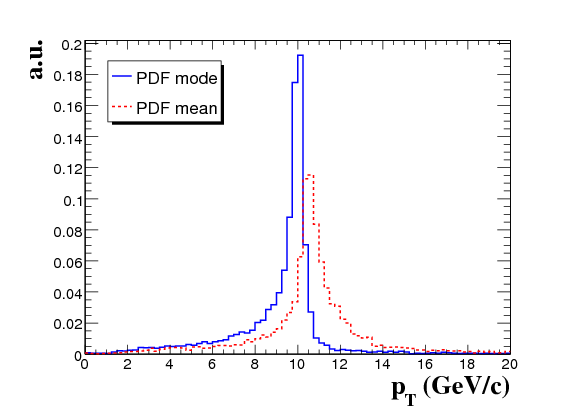 |
Transverse momentum at vertex for pT = 10 GeV/c
electrons. Distributions obtained considering only the mode
of the PDF (blue) and using the weighted mean of all the Gaussians
which enter the PDF (red) are shown.
|
| GIF
EPS |
The tracking used for this plot, and those below, used the following
procedure:
- Trajectory seeding: default track reconstruction strategy, with
two
hits in the pixel detector. Regional seeding was used to reduce
combinatorics: only seeds in a (large) region matching an ECAL
supercluster were considered. The seeds corresponding to all candidate
superclusters were collected, followed by a single cleaning and single
smoothing step.
- The supercluster was obtained using the default ECAL clustering
and superclustering, but the seed cluster ET threshold was
lowered to 1 GeV.
- Trajectory building: the Bethe-Heitler parametrization for the
energy loss was used. An `infinite` chi2 cut is applied to collect hits
up to the outer radius of the tracker.
- Trajectory fitting: the Gaussian Sum Filter was used both in the
forward and in the backward fit.
- Comparisons are shown below of the results obtained with this
configuration and the results obtained with KF tracks. The KF track
results are given for both the default track reconstruction, and the
HLT electron cluster-seeded KF tracks where the seeding is tuned for
background rejection in HLT, and the tracking is tuned for measurement
of the momentum at the vertex.
Trajectory building
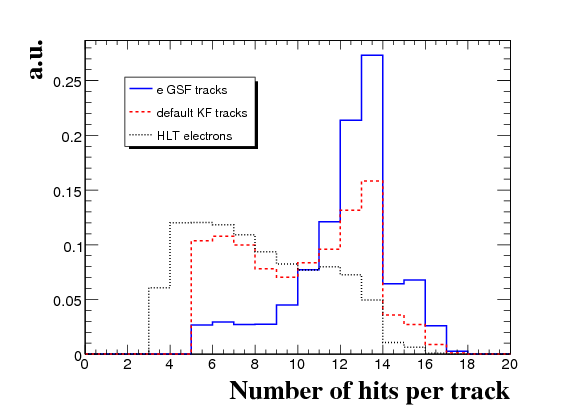 |
Distribution of the number of reconstructed hits per track
for pT = 10 GeV/c electrons.
Distributions are shown for electron GSF tracks (blue), for default KF
tracks (red) and for HLT electron tracks (black). |
| GIF
EPS
|
Track direction measurement at vertex
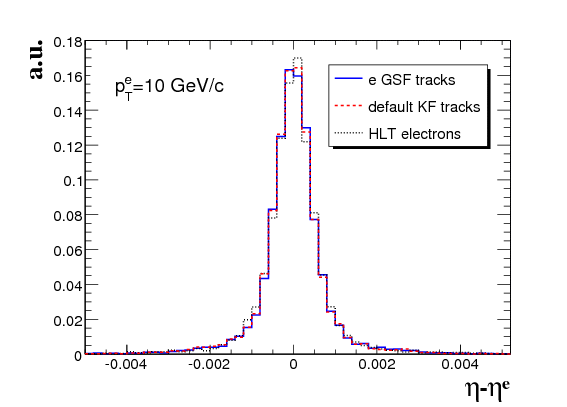 |
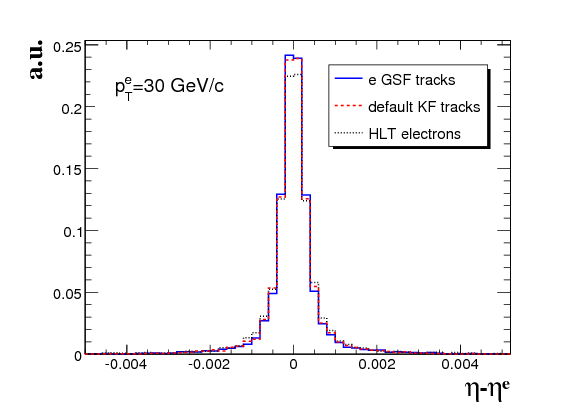 |
Delta eta between the reconstructed and the
generated track for pT = 10 GeV/c (left) and for pT
= 30 GeV/c (right) electrons. Distributions are shown for GSF tracks
(blue), default KF tracks (red) and
the HLT electron tracks (black). |
| GIF EPS
|
GIF EPS
|
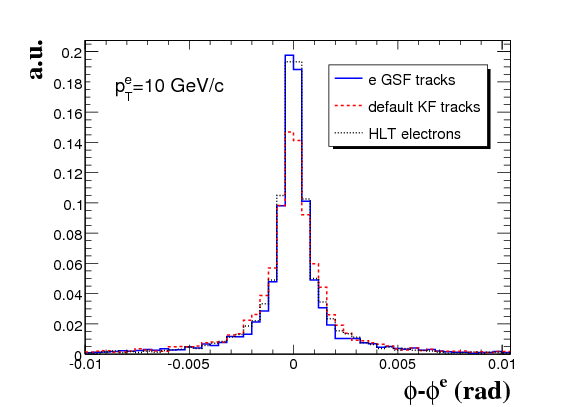 |
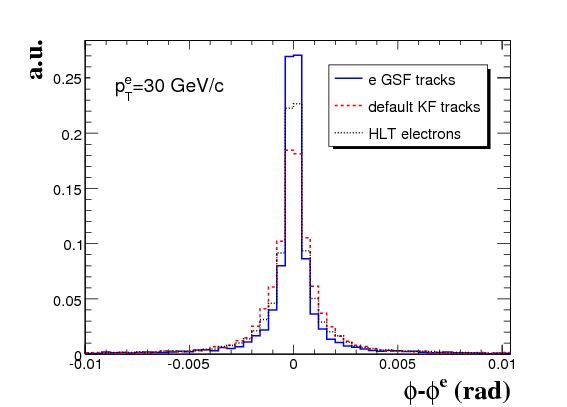 |
Delta phi between the reconstructed and the
generated track for pT = 10 GeV/c (left) and for pT
= 30 GeV/c (right) electrons. Distributions are shown for GSF tracks
(blue), default KF tracks (red) and
the HLT electron tracks (black). |
| GIF
EPS
|
GIF
EPS |
Transverse momentum measurement at vertex
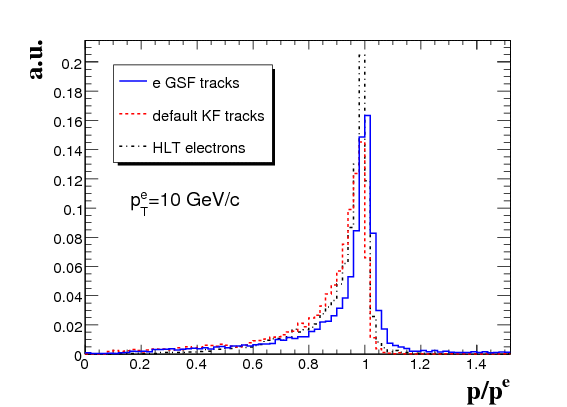 |
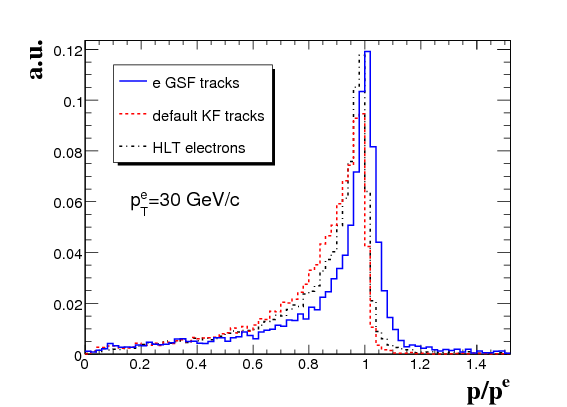 |
Reconstructed momentum at vertex as a fraction of the
generated momentum for pT = 10 GeV/c (left) and for pT
= 30 GeV/c (right) electrons. Distributions are shown for GSF tracks
(blue), default KF tracks (red) and
the HLT electron tracks (black). |
| GIF
EPS
|
GIF
EPS |
Estimation of the energy radiated by bremsstrahlung
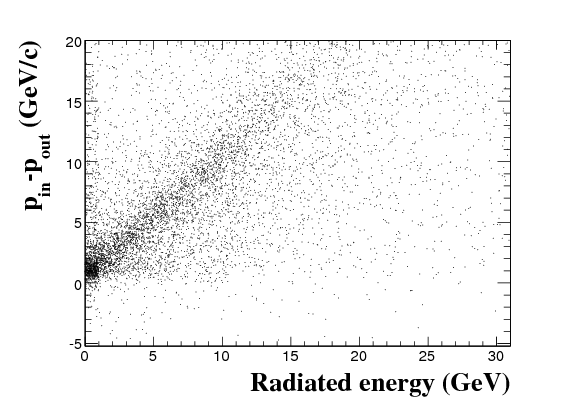 |
Difference between the track momentum at vertex and at the
outermost hit versus the true momentum carried away by bremsstrahlung
photons for pT = 10 GeV/c electrons. The weighted mean of
the gaussians of the PDF is used. |
| GIF EPS
|
Last update: 30 June 2005
Comments: please contact
Chris Seez, Yves Sirois








